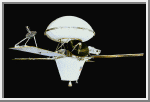











|
NASA's Viking Mission to Mars was composed of two spacecraft, Viking 1 and Viking 2. Each spacecraft consisted of an orbiter and a lander. The primary mission objectives were to
The Viking Landers transmitted images of the surface, took surface samples and analyzed them for composition and signs of life, studied atmospheric composition and meteorology, and deployed seismometers. Viking Lander 2 ended communications on April 11, 1980, and Viking Lander 1 on November 13, 1982, after transmitting over 1400 images of the two sites.
The results from the Viking experiments give our most complete view of Mars to date. Volcanoes, lava plains, immense canyons, cratered areas, wind-formed features, and evidence of surface water are apparent in the orbiter images. The planet appears to be divisible into two main regions, northern low plains and southern cratered highlands. Superimposed on these regions are the Tharsis and Elysium bulges, which are high-standing volcanic areas, and Valles Marineris, a system of giant canyons near the equator. The surface material at both landing sites can best be characterized as iron-rich clay. Measured temperatures at the landing sites ranged from 150 to 250 Kelvin, with a variation over a given day of 35 to 50 Kelvin. Seasonal dust storms, pressure changes, and transport of atmospheric gases between the polar caps were observed. The biology experiment produced no evidence of life at either landing site.
| Viking Images |
|---|
 Viking Mission to Mars
Viking Mission to Mars
The Viking mission to Mars sent twin spacecraft to the Red Planet. This
image shows a model of one of the Viking spacecraft, which were made of
two parts: an orbiter and a lander. The orbiter's initial job was to
survey the planet for a suitable landing site. Later the orbiter's
instruments studied the planet and its atmosphere, while the orbiter
acted as a radio relay station for transmitting lander data. Once on
the surface of Mars, the lander surveyed the soil, wind, and atmosphere
and conducted numerous experiments to determine the existence of past
or present life.
(Courtesy NASA/JPL)
 Launch of Viking 2
Launch of Viking 2
This photograph shows the launch of the Viking 2 spacecraft which
occurred on September 9, 1975. Viking 2 entered Mars orbit on August 7, 1976
and the Viking Lander 2 touched down at Utopia Planitia on September 3, 1976.
The Viking Orbiter 2 was powered down on July 25, 1978 after 706 orbits.
(Courtesy NASA/JPL)
 Parachute Deployment
Parachute Deployment
In this artist's rendering a Viking lander released its parachute just
after entering the Martian atmosphere. When the parachute was deployed,
the lander pod was at an altitude of about 6 kilometers (4.0 miles) and
traveling at a velocity of 900 kilometers per hour (600 mph). Soon after, the lower half
of the heat shield fell away and the lander's legs unfolded. At an
altitude of about 1.5 kilometers
(5,000 feet) the pod separated from the
parachute and using three retro-engines to control its descent, landed
safely on the surface of Mars.
(Courtesy NASA/JPL)
 Viking Touchdown
Viking Touchdown
Captured here in this rendering is a Viking lander just before it
touched down on the Martian surface. The parachute and upper aeroshell
can be seen in the upper left corner of the image. At this stage of
the descent, the lander's terminal descent propulsion system (three
retro-engines) had slowed the craft down so that velocity at landing
was about of 2 meters per second (7 mph). Seconds after the lander reached the
surface it began transmitting images back to the orbiter for relay to
Earth.
(Courtesy NASA/JPL)
 Viking On the Surface of Mars
Viking On the Surface of Mars
This photograph shows a model of the Viking lander on a simulated
Martian surface. The first of the two landers arrived on the surface of
Mars on July 20, 1976. The second touched down on September 3, 1976. Each
lander housed instruments that examined the physical and magnetic
properties of the soil and analyzed the atmosphere and weather patterns
of Mars.
(Courtesy NASA/JPL)
Copyright © 1997-2000 by Calvin J. Hamilton. All rights reserved. Privacy Statement.